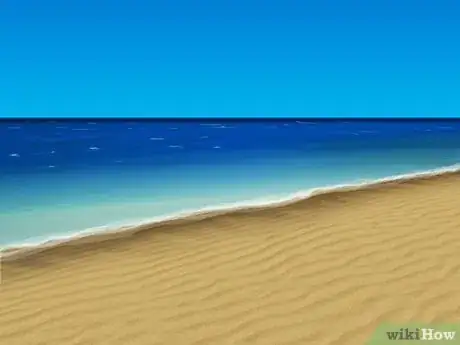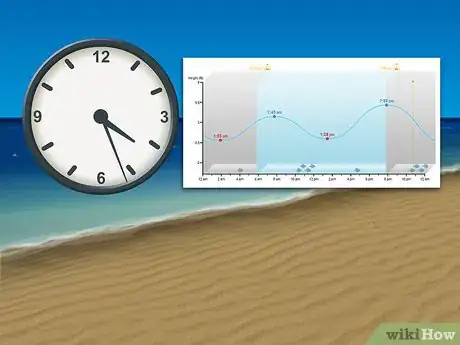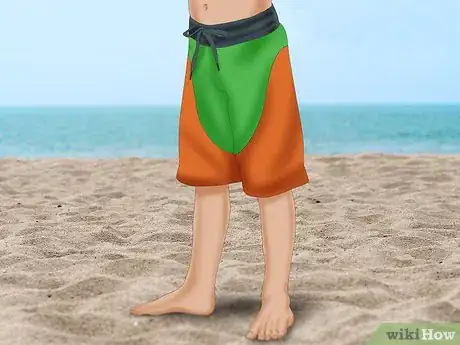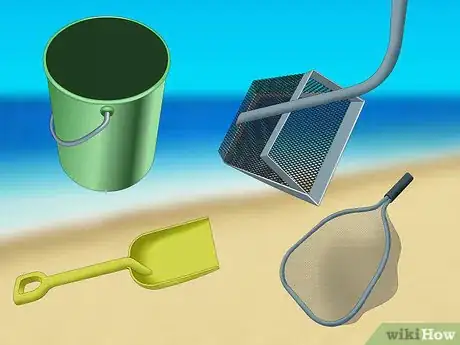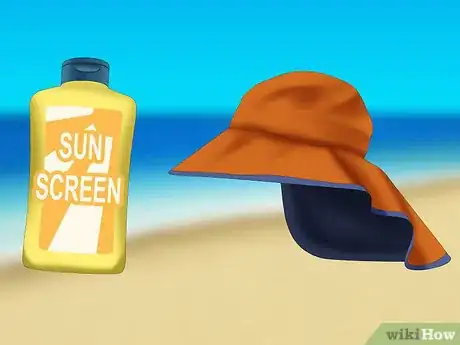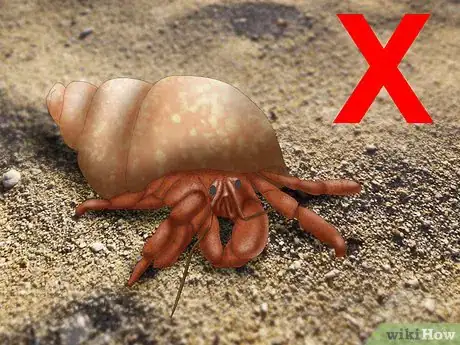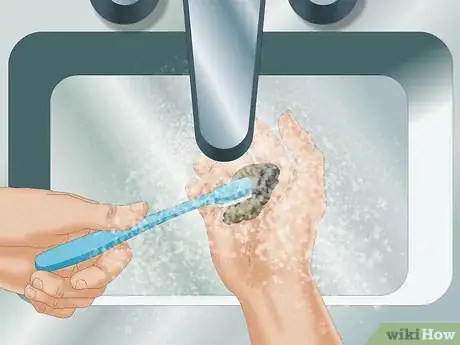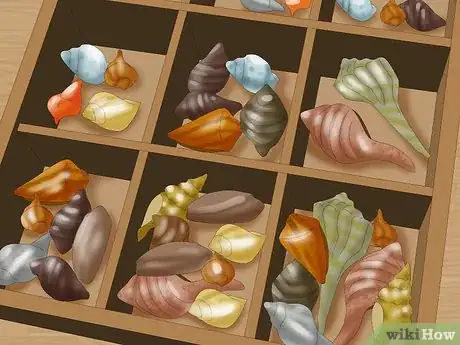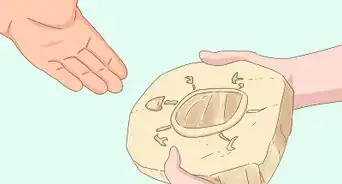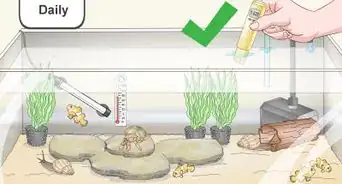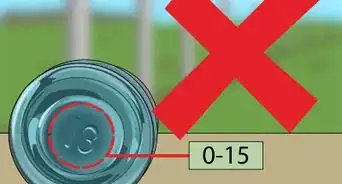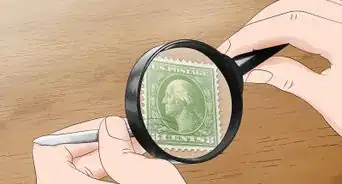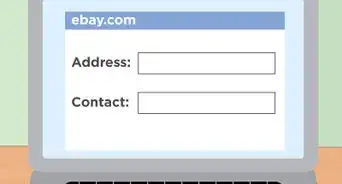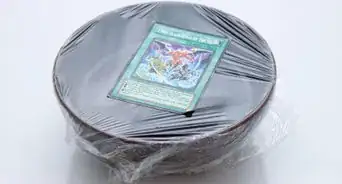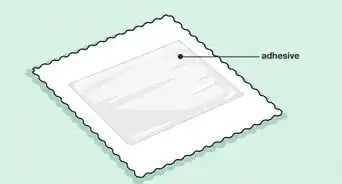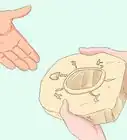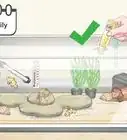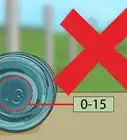This article was co-authored by wikiHow Staff. Our trained team of editors and researchers validate articles for accuracy and comprehensiveness. wikiHow's Content Management Team carefully monitors the work from our editorial staff to ensure that each article is backed by trusted research and meets our high quality standards.
This article has been viewed 102,313 times.
Learn more...
If you’ve been to the beach before, you’ve probably spotted beautiful seashells. If you haven’t been to the beach before, you’ve probably admired them too! Seashells, or Mollusca, come in all sorts of colors, textures, and shapes, so it’s no wonder that they’ve become collector’s items. Whether you’re a casual shell seeker on a family vacation or a serious conchologist, someone who studies and collects shells, there are various tips and techniques to follow to have the best shell-collecting experience.
Steps
Making a Game Plan
-
1Decide how committed you want to be to shell collecting. If you just want some pretty seashells to bring home from vacation, you may not be as curious to learn the peak hours and locations to find particular shells. However, the more serious shell collectors may have specific shells they seek, in which case they will need to do a little more research.
- Keep in mind that if you are a casual shell collector on vacation, you may have issues bringing your shells through airport security.
-
2Figure out which shells are common in your area. There are resources online to determine this. By knowing which shells are most prevalent near you, you’ll know exactly what to keep your eyes peeled for, and it can also give you an idea about how easy or difficult it will be to locate shells.
- If you're committed to finding great shells, you may even consider traveling to find the best ones. If the shells are sparse where you live, or if you don't live near a beach, you can go to some beaches that are famous for their bounty. Sanibel Island, on Florida's Gulf Coast, is regarded by many as the best shell collecting spot in North America.[1]
Advertisement -
3Figure out where you should be looking. Some beaches may be littered with shells, and a casual jaunt down the beach can result in a gorgeous variety. However, other beaches may be bare, and you’ll need to dig a little to find shells. Rocky beaches may contain more shell fragments than intact shells, so you may have to patiently sort through debris to find the shells you seek. In some places, you may even want to snorkel or scuba dive to find the coolest shells. The prime shell spots will vary depending on where you live or travel, so research and explore the beaches near you.
-
4Figure out when you should be looking. Just like hunting or fishing, there are prime times when you’re more likely to find the shells you’re after. When the tide is low, you’ll be able to search for shells that may be covered by water during high tide. More beach is exposed, so low tide is a great time for a shell collecting excursion.
- Tides are caused by gravitational forces between the earth and moon.[2] Tide levels and times depend on where you’re located, so it’s best to look online or in your local paper for tide charts for your area before you head off to collect shells.
- Different varieties of shells often wash ashore during big storms, so you can find some gems if you head to the beach right after bad weather.[3]
Collecting Your Shells
-
1Wear the proper clothing and footwear. If you’re going to be wading deep into water, you may want to wear a bathing suit and skip the footwear all together. If you’re going shell collecting on rocky terrain, you may want to wear sneakers and comfortable clothing.
- Keep in mind that sometimes your feet can be as useful as your hands when collecting shells. By digging into wet mud or sand with your toes, you may be able to find shells that are not visible above surface.
- On that note, be careful so you don’t cut yourself on sharp edges.
-
2Bring a bucket, a net, a spade, a filter, and other tools you may need. You’ll need a bucket to hold all of your new treasures. If you’re interested in searching in deeper waters, using a net to scoop up sand will be more effective than digging around with your hands. With a spade or shovel you can dig out shells you find deep in the ground. A filter or screen can be used to sift through sand and mud. Once you know the habitat and the shells you’ll be collecting, you can determine which tools to bring along with you.
-
3Wear sunscreen and a hat. Nothing ruins a great day collecting shells in the outdoors like a painful, peeling sunburn. Make sure to protect yourself from the glaring sun, especially if you get distracted in your search for shells. A hat or sunglasses can also help shade you from the sun and make it easier to spot shells.
-
4Leave shells with living creatures alone. This is considered proper etiquette among shell collectors. There are beautiful shells that are empty or have a dead creature inside, and those are yours for the taking. If there is a living creature inside a shell you’ve found, give it a chance to live. If it’s washed up, put it back in the surf.
Washing and Organizing Your Shells
-
1Clean your shells. Depending on where you’ve collected them from, they may be covered in dirt or grime, or even animal tissue. Gently washing your shells can make them look beautiful for your display or collection, and can also remove any odor that may linger. You’ll need dishwashing liquid soap, warm water, an old toothbrush, some rags, WD-40 or another lubricant, and possibly tweezers to clean your shells up.
- Scrub your shell with warm water and dish soap using the toothbrush. The brush is great to get into all the ridges and crevices of the shell. You can use the tweezers to pick out any stuck debris or barnacles.
- Dry your shells with the rags, and use the WD-40 to shine them up.
- If your shell has animal tissue attached, you may need to boil it for a few minutes before beginning the cleaning process. Boiling it will loosen up the tissue, and you can use the tweezers to pull out the tissue.
-
2Learn about your shells. While it’s easy to admire shells for their aesthetic beauty, learning about them can give them a whole new layer. Seashells.com provides a thorough shell identification guide, complete with photographs, and you can learn all about the different types of shells you’ve collected. You can show off your newfound knowledge by creating labels and informational cards for each shell, or just learn about them for fun.[4]
-
3Display your shells. There are several great ways to display your new collection. Some collectors fill a clear jar or vase with your treasures, and use it as décor in their home. If you’d rather display your collection methodically with labels, boxes with dividers work excellently. Those can be found at most container stores or craft stores.
- If you want to keep your shells pristine, keep them away from direct sunlight. Shells react differently to bright light, but many are damaged by too much.
- The oil from human skin can also cause wear and tear to the shells. Clear display cases are great to show off your shells without constantly handling them.
Community Q&A
-
QuestionI like collecting shells, and want to eventually sell my collection to shell collectors. Where can I do this?
 Community AnswerYou can try selling your seashells on a general online auction site, like eBay, or search for a shell specific venue for buying and selling, like Conchology, Inc. Another option would be to join an organization of shell collectors, like Conchologists of America, Inc., which would put you in contact with a variety of shell collectors and open new opportunities for selling and trading your shell collection.
Community AnswerYou can try selling your seashells on a general online auction site, like eBay, or search for a shell specific venue for buying and selling, like Conchology, Inc. Another option would be to join an organization of shell collectors, like Conchologists of America, Inc., which would put you in contact with a variety of shell collectors and open new opportunities for selling and trading your shell collection. -
QuestionWhere do we buy these jars from?
 Community AnswerFancy and interesting jars can be purchased from craft stores, home-ware retailers and hardware stores. Try thrift stores and antique stores too, they're bound to have some interesting older jars. Jars can also be very easily sourced from food jars after you've finished the food item; just be sure to wash the jar really well and completely dry it before use.
Community AnswerFancy and interesting jars can be purchased from craft stores, home-ware retailers and hardware stores. Try thrift stores and antique stores too, they're bound to have some interesting older jars. Jars can also be very easily sourced from food jars after you've finished the food item; just be sure to wash the jar really well and completely dry it before use. -
QuestionI only can find seashells that are a couple of inches wide, does it depend where I'm going?
 Mac n cheseCommunity AnswerYes, some beaches may not have very big shells or not many shells. If you want to find bigger shells, you might try going when the tide is lowest.
Mac n cheseCommunity AnswerYes, some beaches may not have very big shells or not many shells. If you want to find bigger shells, you might try going when the tide is lowest.
Warnings
- You’ll most likely be by a large body of water while you’re collecting shells. Use caution, and keep an eye on young children or anyone who cannot swim.⧼thumbs_response⧽
References
About This Article
To start collecting shells, think about how serious you’d like to get before you get started. If you’re just collecting for fun, grab a bucket to store your finds and head to the beach! As you dig, you can use a shovel to get at buried shells, and use a filter to sift through any sand or mud you dig up as well. Finally, look out for live animals in the shells you find, and make sure to either let them be or set them free. If you’re interested, you can also do research about the best beaches in your area and the types of shells you might find! For tips on presenting the shells you’ve collected, keep reading!


